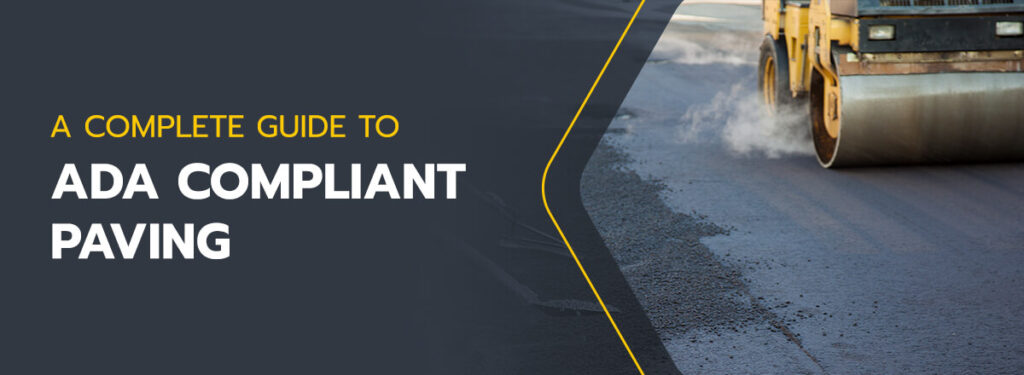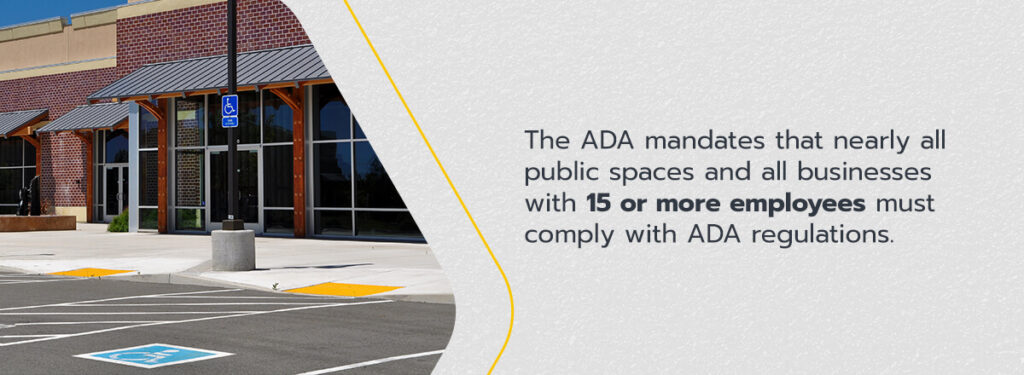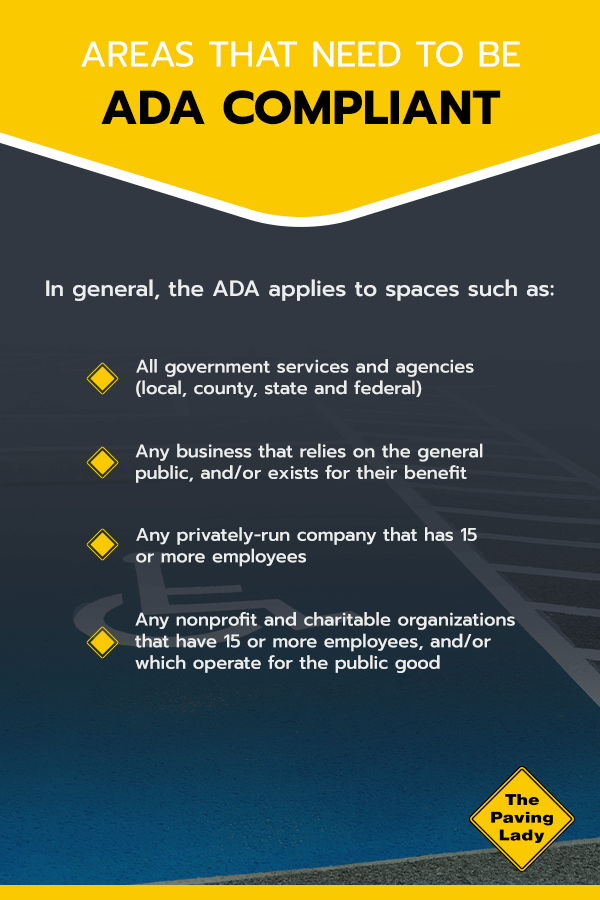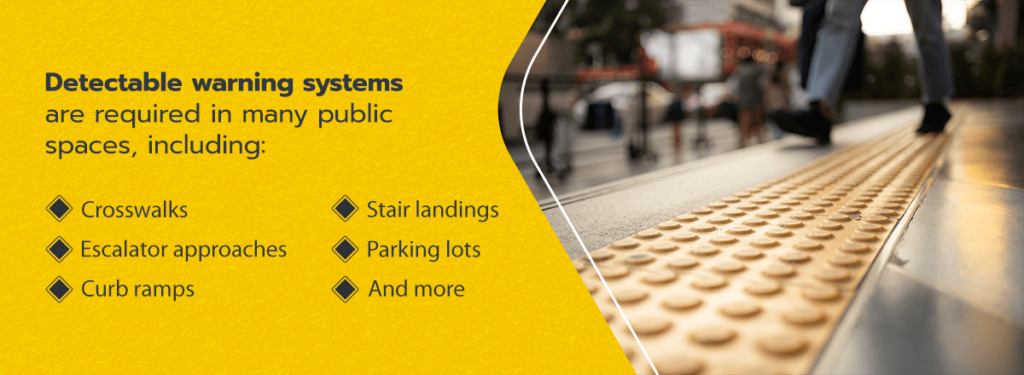
A Complete Guide To ADA Compliant Paving
ADA compliance extends to nearly every aspect of owning a commercial property and/or operating a public business — and paving is no exception to this. Property and/or business owners may find the prospect of implementing ADA-compliant features into the parking lots and other paved features completely overwhelming. This is understandable. The ADA is a complex, comprehensive piece of legislation that most laypeople find difficult to understand in terms of real-world application. If you are a commercial property owner, you will naturally be interested in seeking total compliance with ADA regulations. Not only is ADA compliance the right thing to do from a civil rights perspective, but it will also allow your business to avoid government sanctions and/or expensive fines that can result from noncompliance.
What Is ADA Compliance?
The Americans with Disabilities Act (ADA) refers to federal legislation first enacted in the early 1990s. The ADA was designed to uphold the civil rights of disabled Americans and to ensure they have equal access to all spheres of public life, including jobs, schools, government services, public transportation and all public spaces. The ADA performs a similar function to the Civil Rights Act of 1964, in that both pieces of legislation exist to protect the civil rights of American citizens and to protect all of us from discrimination in any and all aspects of public life. In 2009, the Americans with Disabilities Act Amendments Act (ADAAA) went into effect, which amended some parts of the original ADA and made some changes to the definition and applicability of “disabled” and “disability” as labels.
Essentially, the ADA mandates that nearly all public spaces and all businesses with 15 or more employees must comply with ADA regulations. This typically refers to businesses enacting and maintaining certain modifications and/or accommodations that ensure equitable access for people with disabilities. Some common examples of this include changes like installing ramps and elevators in addition to stairs, installing automatic sliding doors and providing motorized shopping carts, to name just a few.

Because the ADA is a complex legal document that encompasses a myriad of regulations, its significance to businesses and/or property owners are not always easy to understand. To add to the complexity, some ADA regulations will vary from state to state and may be different depending on the size and/or type of business in question.
For these reasons, if you have any questions about what is and is not ADA compliant, you can hire a professional ADA consultant and/or attorney who specializes in ADA compliance to advise you. The ADA is enforced by the U.S. Equal Employment Opportunity Commission (EEOC), so you may also find it helpful to reach out to your local EEOC office for additional ADA guidance.
When it comes to certain features in and surrounding your property or business, such as paving, the paving professionals themselves will likely be able to advise you on ADA regulations and compliance issues. Reputable and trustworthy professional pavers have significant experience with ADA-compliant paving and ADA commercial property regulations.
Paving in general is a specialized skill that amateurs and individuals should not attempt themselves. Ensuring the highest-quality paving for your property and/or business(es) can have long-lasting impacts on your business’s reputation and the connotations that people of all abilities form regarding your property.
Paving, then, is not an aspect of commercial property owners to overlook. Hiring experienced, ADA-compliant pavers will bolster your business’s reputation, ensure access and safety for the disabled, protect your business from legal action — all of which will save you time and money in the long run.
In Miami and the surrounding South Florida areas, The Paving Lady has over 35 years of experience in general paving and ADA-compliant paving solutions. As a business and/or property owner, you can feel confident in trusting their expertise and the high quality of their work.
Areas That Need To Be ADA Compliant
It’s important to keep in mind that specific ADA regulations may alter slightly from state to state, and there can be rare exceptions to its mandates. The following information gives a good, basic understanding of the law’s typical applicability. In general, the ADA applies to spaces such as:
-
All government services and agencies (local, county, state and federal). This includes public libraries, public schools, branches of the U.S. Postal Service, courthouses, city halls, etc.
-
Any business that relies on the general public, and/or exists for their benefit. This includes nearly all spaces in which for-profit businesses exist — for example, most retail stores, restaurants, hotels, banks, car dealerships, airports, train stations, theaters, performing arts venues, etc.
-
Any privately-run company that has 15 or more employees. ADA regulations are not just for the benefit of existing and/or potential customers. These regulations are also in place to ensure equal employment opportunities and accommodations for disabled people in the workforce.
-
Any nonprofit and charitable organizations that have 15 or more employees, and/or which operate for the public good. Examples include spaces such as nonprofit hospitals and healthcare facilities, nonprofit museums, community centers, most private schools, etc.

If your business falls into one of the above categories, then it is legally obligated to adhere to the standards and requirements as set by the ADA and ADAAA. When planning and evaluating your business’s compliance with this legislation, remember that ADA requirements apply to both the interior and the exterior of your business.
Paved areas like parking lots and sidewalks are often overlooked when it comes to ADA compliance, but these spaces are held to the law as equally as indoor spaces. In fact, according to the ADA itself, the top priority for ADA-compliance for any business should be ease of approach and ease of entering the building — essentially, the paved areas outside.
You can think of it this way: if the public isn’t able to access your business in the first place, then it really doesn’t matter if the interior of the business is ADA-compliant or not.
Consequently, parking lots, ramps, curbs and sidewalks are all important areas of consideration when it comes to ADA compliance in a business’ exterior spaces. In order for your business to function efficiently, it’s a good idea to plan paving projects — including repairs and maintenance — in advance, and under the guidance of experienced and trustworthy paving professionals.
ADA Requirements: Paving, Parking Lots and Commercial Properties
Commercial properties have several key elements to consider when implementing ADA-compliant features into their paved outdoor areas. These elements include parking lots, parking spaces, curbs, entrance ramps and ramp landings. While the following guidelines can provide you with a basic overview of ADA paving requirements, they should be considered guidelines only, and not a comprehensive overview of all the specifications to which your commercial property may or may not be subject.
-
Parking lots and parking spaces. Parking lots, when not ADA-compliant, can often be a huge barrier for people with disabilities. As a result, it’s really crucial that commercial properties take all of the steps necessary to ensure that their parking lots and parking spaces allow ease of access for people of all abilities. The ADA provides a simple, straightforward compliance code for parking lots, in order to help businesses know how to implement an ADA compliant parking design. This code should be used to design any new parking lots, and/or to re-stripe any pre-existing parking areas.
-
Sidewalks and curb ramps. Many commercial properties feature sidewalks that separate the entrances to various businesses from the parking lot. Sidewalks naturally necessitate the presence of curbs, and curbs can pose a serious barrier for many people with disabilities — in particular, those who rely on wheelchairs, walkers, scooters and/or other mobility assistance tools. To overcome this issue, the ADA requires curb and sidewalk modification that allows for disabled access. The most common solution is a curb ramp. Essentially, curb ramps are handicap-accessible, paved ramps that cut through the standard curb and grade out to be level with the sidewalk. Often, businesses choose to install these ramps as close to the entrance as possible, in order to increase ease of access for the people who need it. In most instances, curb ramps are made up of a few different key elements:
-
Ramp run. The ramp run refers to the actual paved, sloped surface by which the parking lot connects to the sidewalk.
-
Transition. The transition marks the beginning point, from which the ramp starts its slope, and the endpoint, at which the ramp has become level with the sidewalk.
-
Flares. The flares of a curb ramp refer to the sides of the ramp. The flares can be used to measure the degree to which the ramp grades up to the sidewalk.
-
Any experienced professional paver will likely be well-versed in the design and creation of curb ramps. Of course, it’s important not just to install curb ramps, but to install them in a manner that is itself compliant with ADA standards. The standards for curb ramps are quite specific, and following them accurately is essential. Again, a qualified, professional paving service will likely be able to advise you on up-to-date curb ramp regulations and will know how to create them.
ADA Detectable Warnings Systems
While most people are likely familiar with ADA features such as handicapped parking spaces and curb ramps, you may not be as aware of ADA detectable warnings and detectable warning systems. Though you might not have noticed them, detectable warning systems are required in many public spaces, including crosswalks, escalator approaches, curb ramps, stair landings and parking lots, just to name a few.

So what are detectable warning systems, exactly? And how do they function? In most instances, detectable warning systems are comprised of small, truncated domes or bumps. Typically, these bumps are arranged in square, rectangular or radial groups on the ground.
You’ve likely seen them and/or walked over them many, many times in your life but may not have ever thought about their function. However, detectable warning systems are a crucial part of ADA-compliant paving. These warning systems provide several accessibility features:
-
Audible detection. ADA detectable warning systems are designed so that treading or touching their surface creates a different sound than that of a flat pavement or sidewalk surface. For this reason, these warning systems play an important safety role for people who maneuver the world with the help of guidance canes.
-
Tactile change. The truncated domes which comprise a warning system form a different type of physical surface than that of the flat pavement, and they can be felt underfoot and under-wheel by people of all abilities, whether walking or using a wheelchair or scooter.
-
Visual contrast. ADA regulations state the detectable warning systems must be painted a color in markedly different contrast to the color of the rest of the paved area. Often, they are painted bright yellow, similar to that of crosswalks and other pavement indications.
As with curb ramps, these warning systems require detailed specifications in order to function effectively as a safety and accessibility feature. Rely on the experience of a professional paving service to ensure true ADA compliance for any and all detectable warning systems on your property.
ADA Non-Compliance Penalties
Adhering to ADA regulations is one of the most important things that any business owner and/or commercial property owner can do to ensure the safety of their customers as well as that of the general public. Failure to comply with the ADA can pose serious safety issues, as well as discrimination and civil rights infringements. As a result, failure to comply with ADA regulations generally comes with serious and far-reaching consequences.
Under federal law, you may be fined up to $75,000 USD for the first time you violate the ADA. Any additional violations can result in fines of up to $150,000 USD each. Other serious fines and sanctions may occur, should your business continue to fail to meet ADA standards. In some cases, this may even result in the temporary closure of your business.
In addition, lack of ADA compliance opens up your property and/or business to potentially expensive, lengthy lawsuits and other legal actions. It’s in the best interests of both public safety and the reputation of your business to meet and continually uphold ADA regulations.
The Paving Lady: Experts In ADA Compliant Paving Solutions
In most instances, trusting a professional, experienced paver is the easiest, simplest and most cost-effective way to ensure that your property and/or business are — and remain — up-to-date and compliant with all federally mandated ADA regulations.
The Paving Lady has over 35 years of experience providing high-quality paving solutions for business and property owners in Miami and the surrounding South Florida region. Our services include both asphalt and concrete paving, ranging from large-scale commercial jobs to small, one-off residential projects. We pride ourselves on providing the highest-quality work, along with excellent customer service and fair pricing.
Our expertise with ADA paving regulations and all industry best-practices make The Paving Lady the top pavers in South Florida. Contact us today with any questions, and we will be happy to turn your paving dreams into reality.

